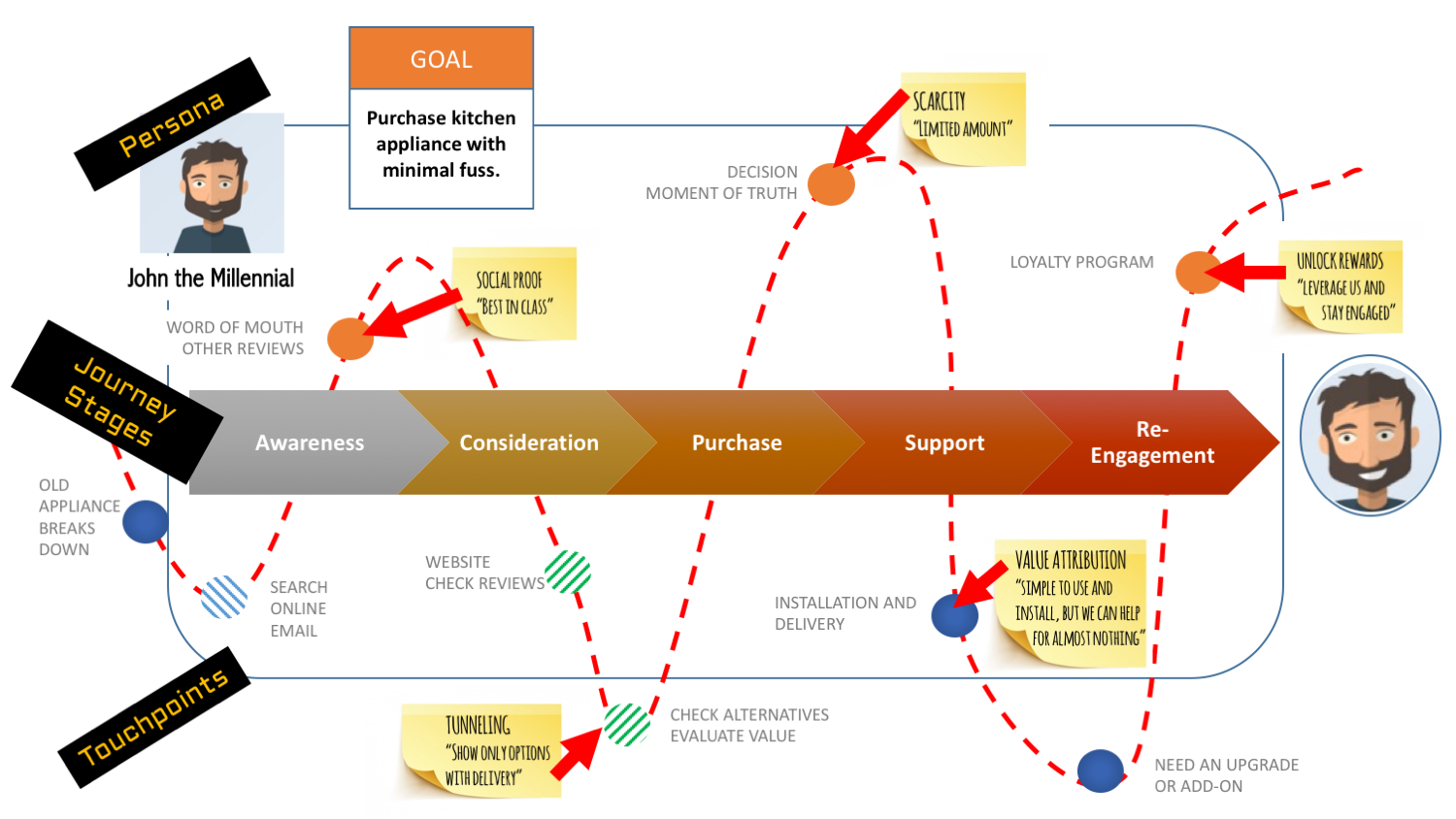7 killer ways to influence user behaviour
Discover the persuasive design techniques that can help you influence your users' behaviour.
Websites employ psychological techniques to influence the behaviour of their users. Drawing on decades of academic research that explains how our mind works and how we make decisions, designers can use subtle triggers to make users pay attention, sign up to a new service, make it more likely they buy a product, spend more, or even create a new habit.
Some sites use gaming elements to drive engagement, while others – such as Apple – use poetic techniques to make their copy more memorable. We talked to a few experts to find out how to apply psychology to create a persuasive user experience, and what to do or not to do. Here’s what they had to say:
01. Apply the scarcity effect
Victor Yocco, author of Design for the Mind, is a big fan of accounting for heuristics, or mental shortcuts, in design.
“People love to think they are getting something others might not have access to – something exclusive. People also assume a higher value in things coming in limited quantities. It’s called the scarcity effect. People are more likely to take an action when something has limited quantities or availability. We can use this to our advantage by including design elements such as timers while making a decision."

“On an ecommerce site, show users quantities of certain items are limited, or have flash sales on items that only last a certain time," he continues. "On a content-focused website, allow users to upgrade and access exclusive premium content. Or show users a sneak preview and then ask them to commit to a subscription to view more. If you’re releasing a new product or major update, give people ‘exclusive invitations’ and let them invite a limited number of friends to have a sneak preview. We see successful digital properties from Amazon and Ebay to news sites offering exclusive content to subscribers only.”
02. Make use of social influence
Yocco also suggests implementing social elements into your product.
“People are inherently social,” he explains. “People want to use the products their friends and peers use. They also want to socialise with each other when it makes sense. We see this in the spread of social media and success of companies like Facebook and Snapchat. Adding design elements facilitating social experiences can help your product stand out and increase use.”
Daily design news, reviews, how-tos and more, as picked by the editors.
Here are some tips for maximising the benefit of social influence for your product that Yocco recommends:
- Offer direct access to sharing content or product information from individual pages
- Allow importing of friends or send invitations to use your product directly to users’ lists of friends
- Show users people they know have used your product (e.g. 10 of your Facebook friends are registered for this site) and how they have used your product
- Provide a newsfeed where users can see real-time updates and interact with each other
- Create competition between users to facilitate greater use
Further reading: Designing social proof into your ecommerce website.

03. Apply persuasion tactically over the user journey
Alberto Ferreira, UX and communication researcher and author of Universal UX Design, recommends applying techniques in a more integrated manner.
“Persuasion is not a library of techniques, but a dynamic combination of stimulation, context, and behaviour. Persuasion cannot work in isolation. You can apply scarcity as a persuasive message, frame a high price as great value for money, or establish social proof to validate your product with the wisdom of the crowds. Then sit patiently and wait for the A/B results to start rolling in.
“Or you can apply persuasion strategically by mapping out the decision processes that your customers go through in their journey. Would they be loyalists or regulars? When are they accessing your website or app? Commuting in a full train car, or during the most freeing roadtrip of their lives? What are they looking to buy? What are they aspiring to as individuals?
“To use persuasion effectively, map out the three fundamental dimensions of consumer behaviour: emotion, motivation, and ability. Segment strategically in a data-driven manner, gain insight into their journey, and understand the assumptions and values that your customers are bringing into the process. Then apply persuasive techniques tactically, whether it is aiming at an impulsive click or tap, or to improve the brand perception (and re-engagement) over the course of several visits. Doing it the other way around will only alienate and infuriate your users. Or, at worst, make you seem desperate.”
04. Influence user behaviour with nudges
User experience designer Russell Parrish, currently at IBM, has come up with a catalog of UX patterns.
He explains: “Richard Thaler wrote in his book Nudge that a nudge is, ‘a small feature in an experience that attracts our attention, and influences the behaviour we make.’ User experience designers for the most part stumble across the concept of nudging. We have these powers to influence user behaviour, and have seen them in common digital experiences, but lack the resource to reference these patterns.
“At IBM we are obsessed with designing experiences that are centred on users and have created a nudge library to aid designers in making ethical nudge decisions. Right now the library is in its infancy and will continue to grow as we add visual examples of nudges in use cases. Taking a behaviour-based approach to UX design will make more compelling experiences that better fulfil the users' and business’ demands.”
For more on Parrish's research, see his site.

05. Consider what people are trying to achieve
According to industry analyst Horace Dediu, one of the greatest difficulties in business is determining user intentions.
“We don’t have an understanding of the causes of behaviour and are thus always guessing and misallocating our resources,” he explains. “Apart from intuition, which is hard to reproduce, the best clues I’ve been able to find have come from a process of analysis of ‘jobs to be done’ for the consumer. This is not a utilitarian view of intention or a measurement of economic value. Rather, it’s an understanding of the urges people feel that compel them to do things.
"These urges are deeper feelings and motivations that are often unstated and cannot be explained by those who have them. In order to influence behaviour it makes sense to understand what they are actually trying to achieve and offer them a way of achieving that. This provision of progress opportunities is what UX analysis and design is all about.”
06. Design a great service
Harry Brignull, independent user experience consultant and curator of Darkpatterns.org, warns to use persuasive techniques carefully.
“When you think about influencing user behaviour, it's tempting to think about cognitive biases (like scarcity and social proof), then do a bunch of A/B tests,” he says. “You'll get some uplifts and you'll probably feel good about yourself. Don't. This is the hallmark of a business that is comfortable in mediocrity, and that will be easily disrupted by the next big thing.
“The best way to influence user behaviour is to design a great service that fulfils user needs. Great services sell themselves.
“So, do user research. Build a deep understanding of user needs. Work on your core service design. If you build something people really want, the persuasion will be easy.”
07. Know your boundaries
UX consultant Joe Leech agrees and recommends considering the ethics of how you use your design.
“At the start of my career I worked for a major UK bank on a project to redesign a credit card application process,” he explains. “At the time interest rates were low and banks were making money on selling insurance that protected the applicant against illness and lay-off. The commercial focus on selling these products led to an awful lot of pressure on me as a designer to use psychology to influence uptake. I felt uncomfortable – so much so that I held ideas back so I didn’t feel like I was tricking people. Subsequently, the UK Government has ruled that practices of the time were unlawful.
"The lesson I learnt was it was important to know your boundaries; to not approach a project where there was the potential to use design for the wrong ends. It spurred me on to develop my own code of conduct:
- Don’t trick
- Don’t cheat
- Don’t lie
- Provide positive benefit
I suggest you decide on your own boundaries, ethics and limits.”
Joe Leech will present a workshop on psychology for UX and product design at Pixel Pioneers Bristol on 7 June, which will be followed by a one-day conference covering design systems, inclusive design, variable fonts, content design, perceived performance, user testing and more.
Related articles:

Oliver is an independent editor, content consultant and founder of Pixel Pioneers. Formerly the editor of net magazine, he has been involved with the web design and development industry for more than a decade and helps businesses across the world create content that connects with their customers. He is passionate about content, user experience, accessibility and designing for social good.

